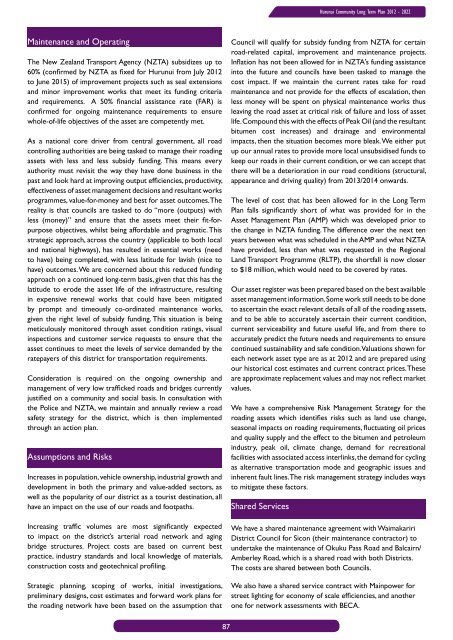Draft Long Term Plan 2012-2022 - Hurunui District Council
Draft Long Term Plan 2012-2022 - Hurunui District Council
Draft Long Term Plan 2012-2022 - Hurunui District Council
You also want an ePaper? Increase the reach of your titles
YUMPU automatically turns print PDFs into web optimized ePapers that Google loves.
<strong>Hurunui</strong> Community <strong>Long</strong> <strong>Term</strong> <strong>Plan</strong> <strong>2012</strong> - <strong>2022</strong>Maintenance and OperatingThe New Zealand Transport Agency (NZTA) subsidizes up to60% (confirmed by NZTA as fixed for <strong>Hurunui</strong> from July <strong>2012</strong>to June 2015) of improvement projects such as seal extensionsand minor improvement works that meet its funding criteriaand requirements. A 50% financial assistance rate (FAR) isconfirmed for ongoing maintenance requirements to ensurewhole-of-life objectives of the asset are competently met.As a national core driver from central government, all roadcontrolling authorities are being tasked to manage their roadingassets with less and less subsidy funding. This means everyauthority must revisit the way they have done business in thepast and look hard at improving output efficiencies, productivity,effectiveness of asset management decisions and resultant worksprogrammes, value-for-money and best for asset outcomes. Thereality is that councils are tasked to do “more (outputs) withless (money)” and ensure that the assets meet their fit-forpurposeobjectives, whilst being affordable and pragmatic. Thisstrategic approach, across the country (applicable to both localand national highways), has resulted in essential works (needto have) being completed, with less latitude for lavish (nice tohave) outcomes. We are concerned about this reduced fundingapproach on a continued long-term basis, given that this has thelatitude to erode the asset life of the infrastructure, resultingin expensive renewal works that could have been mitigatedby prompt and timeously co-ordinated maintenance works,given the right level of subsidy funding. This situation is beingmeticulously monitored through asset condition ratings, visualinspections and customer service requests to ensure that theasset continues to meet the levels of service demanded by theratepayers of this district for transportation requirements.Consideration is required on the ongoing ownership andmanagement of very low trafficked roads and bridges currentlyjustified on a community and social basis. In consultation withthe Police and NZTA, we maintain and annually review a roadsafety strategy for the district, which is then implementedthrough an action plan.Assumptions and RisksIncreases in population, vehicle ownership, industrial growth anddevelopment in both the primary and value-added sectors, aswell as the popularity of our district as a tourist destination, allhave an impact on the use of our roads and footpaths.Increasing traffic volumes are most significantly expectedto impact on the district’s arterial road network and agingbridge structures. Project costs are based on current bestpractice, industry standards and local knowledge of materials,construction costs and geotechnical profiling.Strategic planning, scoping of works, initial investigations,preliminary designs, cost estimates and forward work plans forthe roading network have been based on the assumption that<strong>Council</strong> will qualify for subsidy funding from NZTA for certainroad-related capital, improvement and maintenance projects.Inflation has not been allowed for in NZTA’s funding assistanceinto the future and councils have been tasked to manage thecost impact. If we maintain the current rates take for roadmaintenance and not provide for the effects of escalation, thenless money will be spent on physical maintenance works thusleaving the road asset at critical risk of failure and loss of assetlife. Compound this with the effects of Peak Oil (and the resultantbitumen cost increases) and drainage and environmentalimpacts, then the situation becomes more bleak. We either putup our annual rates to provide more local unsubsidised funds tokeep our roads in their current condition, or we can accept thatthere will be a deterioration in our road conditions (structural,appearance and driving quality) from 2013/2014 onwards.The level of cost that has been allowed for in the <strong>Long</strong> <strong>Term</strong><strong>Plan</strong> falls significantly short of what was provided for in theAsset Management <strong>Plan</strong> (AMP) which was developed prior tothe change in NZTA funding. The difference over the next tenyears between what was scheduled in the AMP and what NZTAhave provided, less than what was requested in the RegionalLand Transport Programme (RLTP), the shortfall is now closerto $18 million, which would need to be covered by rates.Our asset register was been prepared based on the best availableasset management information. Some work still needs to be doneto ascertain the exact relevant details of all of the roading assets,and to be able to accurately ascertain their current condition,current serviceability and future useful life, and from there toaccurately predict the future needs and requirements to ensurecontinued sustainability and safe condition. Valuations shown foreach network asset type are as at <strong>2012</strong> and are prepared usingour historical cost estimates and current contract prices. Theseare approximate replacement values and may not reflect marketvalues.We have a comprehensive Risk Management Strategy for theroading assets which identifies risks such as land use change,seasonal impacts on roading requirements, fluctuating oil pricesand quality supply and the effect to the bitumen and petroleumindustry, peak oil, climate change, demand for recreationalfacilities with associated access interlinks, the demand for cyclingas alternative transportation mode and geographic issues andinherent fault lines. The risk management strategy includes waysto mitigate these factors.Shared ServicesWe have a shared maintenance agreement with Waimakariri<strong>District</strong> <strong>Council</strong> for Sicon (their maintenance contractor) toundertake the maintenance of Okuku Pass Road and Balcairn/Amberley Road, which is a shared road with both <strong>District</strong>s.The costs are shared between both <strong>Council</strong>s.We also have a shared service contract with Mainpower forstreet lighting for economy of scale efficiencies, and anotherone for network assessments with BECA.87
















